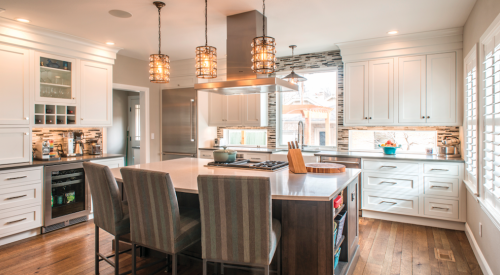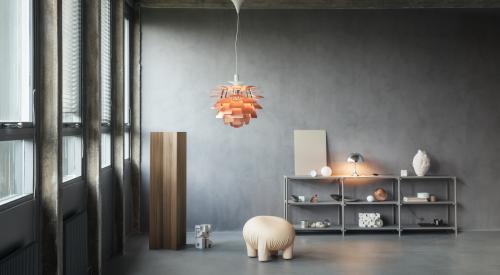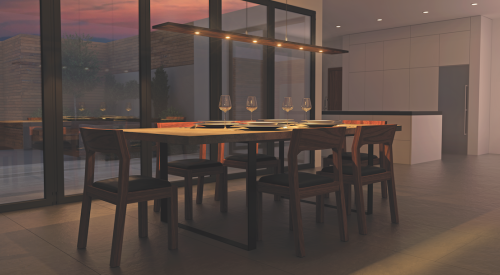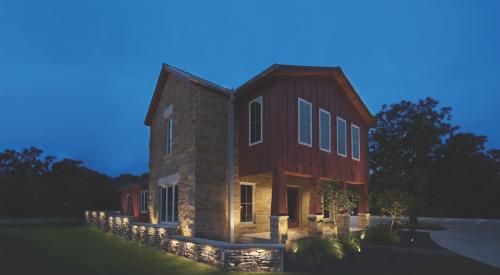| A living room calls for variable mounts of lighting for different activities such as entertaining, reading and listening to music and for making a welcoming first impression. Recessed lights are a natural for the general lighting requirements of the living room. Place fixtures in a symmetrical pattern around the room for balanced lighting. |
Good lighting falls into that vague "I can't tell you exactly what it is, but I know it when I see it" category, but lighting need not be a hit-or-miss proposition. Although a sophisticated lighting plan can get fairly complicated and technical, some basic rules illuminate the process for builders.
Lighting designers, architects, interior designers and builders alike stress the importance of a good lighting scheme. "You can have the finest accoutrements one can purchase in a home, but without good lighting, it doesn't show up," says Rick Ortega of The Lighting Studio, a lighting design firm in Aspen, Colo.
Unfortunately, lighting often takes a back seat to other details. "Out of everything that a builder purchases to go into a home, I think lighting is one of the last things they spend money on," says Jennifer Stephens, a designer at Faro Lighting in the St. Louis area. She says home buyers' degree of lighting savvy can vary greatly, too, so it's up to builders - and their lighting designers and architects - to steer buyers to good decisions.
Whether you're a production or custom builder, working with clients or planning standard and upgrade packages, keep the following three things in mind.
Determine Lighting Needs
| Stairways need proper lighting to ensure the safety of residents and guests. Relatively high levels of light also illuminate pictures and art objects often placed on these large walls. Using recessed fixtures keeps a clean appearance, and high wattage trims, such as a high-wattage baffle or reflector using a 150W PAR38 or 150W R40 lamp (a Halo 410 baffle is pictured here), provide a high light level. |
Lighting fits into three main categories - general or ambient, task and accent - although a variety of techniques can be used to achieve everything from a simple design to an elaborate display. See the glossary [at right] for more detail.
For each room or area to be lighted, consider the activities that will take place there. If the dining room acts only as a place for eating, lighting sufficient for eating and entertaining is essential, but it need not be high illumination. Setting a mood is just as important.
Usually, the dining room table pitches in as a homework station and hobby surface, so the lighting choices need to focus on those roles, too. That means a builder might choose several lighting options - the traditional center chandelier (preferably on a dimmer) but also wall sconces and probably recessed cans for brighter task lighting.
In a workout room, the needs might be quite different. "Here you want general lighting and wall washing so it's a comfortable environment with a more diffuse kind of light," says Glenn Siegel, director of marketing for Cooper Lighting.
If someone is on the floor doing sit-ups, the last thing she wants is overhead lights in her eyes. Cove lighting and track lighting along the perimeter work well, bathing the walls in light to gently reflect and amplify the light.
Think about the objects and art, architectural features and display areas that crave attention. In living rooms and family rooms, accent lighting likely takes precedence over task lighting and does much of the ambient lighting. Sea Gull Lighting designers recommend spotlights or wall washing for accent.
|
For tasks, bringing the light to the task works best, with hanging or portable fixtures, track lights or spotlights. Sea Gull warns builders to look out for possible glare with spotlights and take care when using recessed lights for tasks as they can be inflexible if furniture layouts and room activities change.
A builder working with clients, or even a model home with an interior designer, has an advantage here, as clients can be asked about needs, activities and furniture layout. But even production builders and spec builders can make educated guesses. Areas above a fireplace generally showcase art, as do long walls in entryways; home offices require good focused lighting; and so on.
Think about who will live there, too. Do they entertain often? If so, they might want lighting options for everyday use but also subtle lighting effects that play up architectural features, help zone a large room into conversation and activity areas and set the mood. If they collect art, accent lighting provides not only proper illumination but also the correct angles, shadows and other effects. In addition, older people often require brighter light as their vision diminishes.
Choose Fixture Types
"It is incumbent that the right type of lighting is first chosen based on the construction," Siegel says. Consider the joist spacing, where ductwork runs, the ceiling height and whether the fixture will come in contact with insulation (requiring an insulated ceiling-rated, or IC-rated, fixture). The scope of options available makes construction limitations fairly easy to overcome, but check with your lighting supplier or manufacturer if you are unsure about using a fixture correctly.
Generally, a room works best when a mix of lighting is used. By far the most popular choice, recessed can lights work in all situations because they are fairly inconspicuous and quite flexible. Siegel notes they have improved dramatically over the years and are often smaller and designed with white instead of black baffles so homeowners see the light, not the fixture.
| Hidden lights add depth and drama to the ceiling, as well as provide ambient light. Spotlights and a recessed can (in the niche) highlight the homeowner's art. |
Bloomfield Hills, Mich.-based architect Dominick Tringali, however, says he has seen a decrease in the use of cans during the past few years, with a greater emphasis on surface lighting with decorative fixtures. Every year, manufacturers create new collections of surface lighting - chandeliers, sconces, ceiling fixtures and even floor and table lamps - that suit any budget. Expect to see new ones soon - a twice-annual lighting show took place in Dallas in late June.
Another top pick, the pendant light, shows up a lot in the kitchen, especially over islands, to deliver stylish task lighting. Builder Bill Berry of Fischer & Frichtel in Chesterfield, Mo., likes smaller pendant lights that ride on a narrow, flexible wire because they manipulate easily and are very airy and open.
"There are just so many types of lights now," Berry adds. "Where before you only used the big track lights, now that's like putting a '57 Chevy hubcap on the ceiling." In addition to the finishes popular everywhere in the house - brushed and antiqued metals especially - glass shades in cobalt blue and other bright colors are big.
Shorten the Learning Curve
"A lot more builders are getting serious about lighting," Tringali says. "The right lighting just makes a house look better." Builders have a lot of opportunities to bone up on it, some of which are right under their noses.
Many manufacturers, including Cooper, Sea Gull and Juno, offer lighting courses on the basics and beyond and often have large learning facilities at corporate headquarters. Sea Gull's "designer tips" section on www.seagulllighting.com contains plenty of free information and ideas, too.
Siegel adds that builders can find real benefits in working with a skilled lighting designer at least once - and paying very close attention. Builders can locate designers in their area by contacting local showrooms or the International Association of Lighting Designers.
| Photo courtesy of Progress Lighting |
The key to kitchen lighting is to provide sufficient task lighting while also creating a warm, inviting atmosphere.
Source: Progress Lighting
| Photo courtesy of Progress Lighting |
Source: Progress Lighting
| Photo courtesy of Barley + Pfeiffer Architects |
"From an energy-efficiency standpoint, fluorescent is much better than halogen or incandescent because you get more lumens [light] per watt," says Peter Pfeiffer, principal of Barley & Pfeiffer Architects in Austin, Texas. Fluorescents can last 10 times longer than incandescents and reduce energy use by 50-70%. Still, they battle a bad rap - people falsely assume they shed an unflattering light, flicker and hum - but they have improved dramatically.
Halogen lighting is 30-50% more efficient than incandescents and performs best as focused light, as in wall fixtures or accents, as opposed to indirect lighting.
According to Green Building Guidelines, published by the Sustainable Buildings Industry Council, energy-efficient lighting suits highly trafficked and continually used areas such as kitchens and family rooms especially well.
Pfeiffer warns against overuse of one of the most popular types of fixtures, recessed cans. "They tend to let a lot of heat out in the winter and humidity in the summer, even the so-called airtight ones. We really try to reduce their use in houses where people are concerned with energy efficiency or indoor air quality." Excess humidity, even just a little bit, invites mold growth.
Last but certainly not least, consider the "free" light that comes from the sun. Clerestory windows provide reflected light without glare. Skylights and plenty of standard windows are options, but the heat gains and losses might offset their lighting-efficiency benefits, according to Green Building Guidelines. Consider shading windows with overhangs and using low-E window glass.










